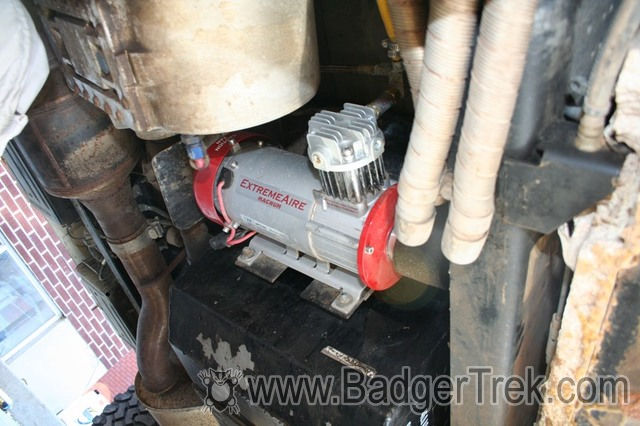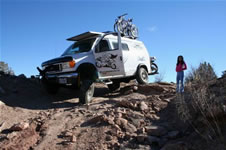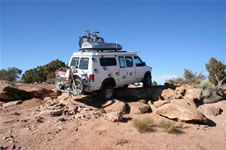www.BadgerTrek.comAbout/ContactWeb LogOur Camper Van
Resources:Hobbies:MotorcyclesAmy's CakesOutboard Hydroplane RacingRadio Controlled Toys |
Sportsmobile 4x4 Drivetrain and Suspension
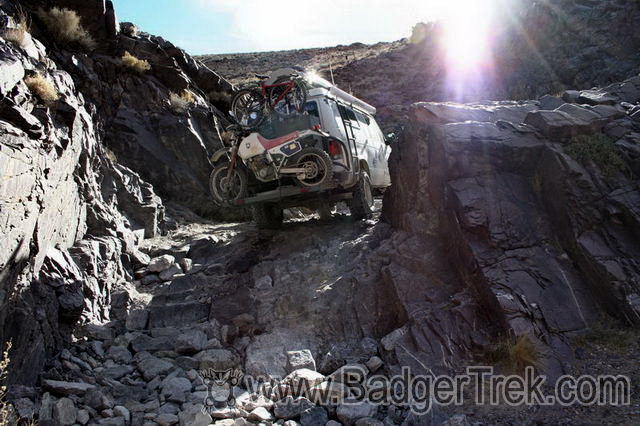
How it came:
The van was ordered with Sportsmobile CA's own 4x4 conversion, 16x8 Weld forged rims with 285/75R16 BFG AT tires (32"), and a hard-mounted ExtremeAire compressor & tank for airing up tires.
The system has really helped us get into, and out-of, some very remote and beautiful sites for setting up camp. We are often at the end of a jeep-track or road on top of a hill with an awe-inspiring view and no visitors other than the wildlife.
The 4x4 conversion uses an Atlas II transfer case from Advanced Adaptors, Dynatrac Pro Rock 60 front axle, Warn premium manual locking hubs, 46 gallon Transfer Flow replacement fuel tank, quick-disconnect front anti-sway-bar, Old Man Emu shocks (ARB), front leaf spring suspension, and rear lift blocks.
After a number of years of posession, a fair bit of on-and-off road travel, and quite a bit of research I have a few nits to pick with the 4x4 system. Overall I have no significant complaints, the major components are top-of-the-line, and it works as advertised but there are a few small things that bug me.
Issues:
- Shock bolts: The bolts holding the shocks are grade 5 (how much more would grade 8 be? Cost me about 4$ at my local hardware shop to replace with grade 8). Also the bolts are in double sheer, but the sheer stresses are in the threaded portion of the bolt for one of the sheer points. The shank should be longer so the stress is not on the weaker threaded portion of the bolt (to see what type of problems this can cause, see our writeup on our penthouse failure at the bottom of the November '05 log).
- Shock mounts: The shock mounts are wider than the bushings in the ends of the shock that they hold. This results in the shock mounting bolts either crushing the mounts in towards the shock bushing, or the shock being free to slide about a few mm on the bolt. Some properly sized washers would have prevented this. Ours mounts came bent from the bolts being tightned up, and I would rather not bend them back, but this results in the shock body rubbing on the mounts to some extent.
- Rear lift-blocks. The rear lift is accomplished by some fairly tall lift blocks. The whole concept of tall lift blocks on an axle that carries significant torque (accelerating or braking) is a bit of a concern to me (axle spring wrap). I think I would prefer an inverted shackle system, such as used on the front springs, to obtain the majority of the lift. I realize that this would add a fair bit of complexity and cost to the manufacturing.
- Getting the anti-sway-bar quick-release links off is a royal pain, as is getting them back on. The van has to be absolutely level to remove torsion from the bar, and the fit is tight. Perhaps there's a technique to it we haven't figured out yet. Also, one of the pins that hold the links was not welded very well, and has popped loose from the axle mount. It is still through a hole in the axle mount, so everything stays together, but it falls out if the links are removed. Lubricating (parifin) the steel pins and bushings a bit really helps getting them on and off, though it attracts some dust. After around 20,000 miles the pin on the other side of the axle broke its weld too, but is still held in by the shape of the break (though it rattles).
- The right tire hits the fender plastic when turned to full right-lock, and a bump is encountered. A tremendously concerning sound is generated when this happens.
- The springs, both front and rear, looked to be loaded a bit too much, or not arched enough, as they are all slightly concave upwards, with only about 1" to the bump-stops. This configuration seems to defeat the purpose of the rear shackle on the front suspension, as the front axle will want to move forward for any bump it hits, rather than rearwards.
- After about 19,000 miles we had the plate holding the leafspring, shock, and axle together (driver's side) break. I noticed a strange squeak, and the handling was off, so we stopped at the next possible place and looked around. The U-bolt was loose and ready to fall off, leaving the axle effectively un-mounted.
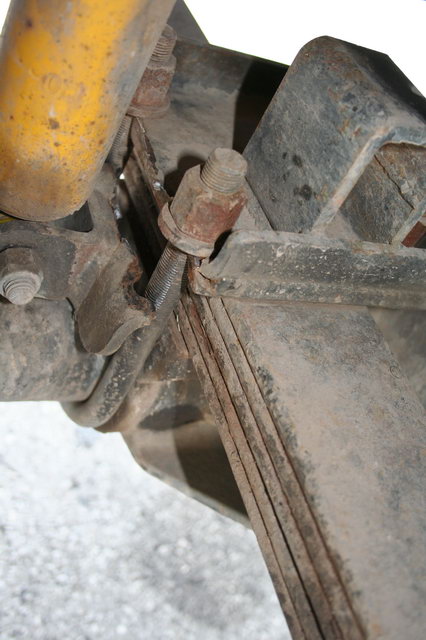
- 4000 miles after replacing the above mentioned U-Bolt plates, the new passenger side one developed a crack where the track bar attaches. This is not nearly as critical as the prior break, but still something requiring replacement
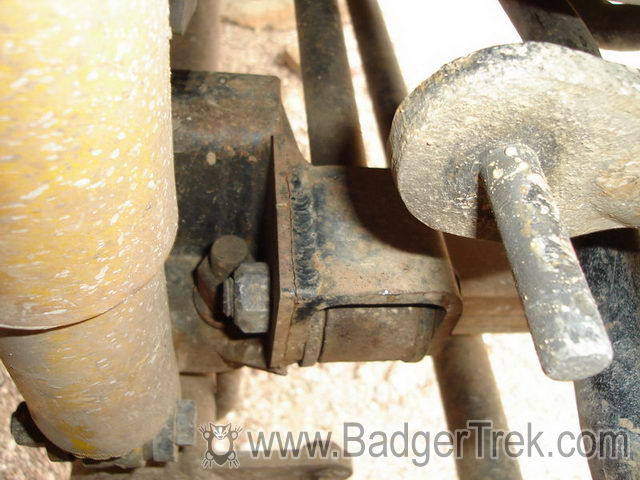
- At about 30,000 miles the axle-side eye on the front axle track-bar broke, allowing the axle to shift side-to-side more freely, causing wandering in the steering and permitting the front drive-shaft to strike the transmission filter housing.
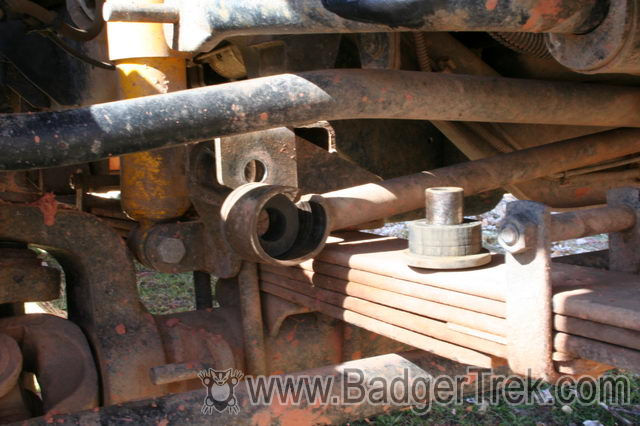
- In one 4x4 trail incedent we suddenly lost all front input with a loud bang, followed by a rather ominous grinding noise. A bit of trouble-shooting found that the left front hub was no longer engaging the axle. Disassembly of the hub showed that the star which pushes the lock-ring spring in and out had skipped a thread on its ramp and let the lock-ring back out. Field reparable, but the design seems a bit weak.
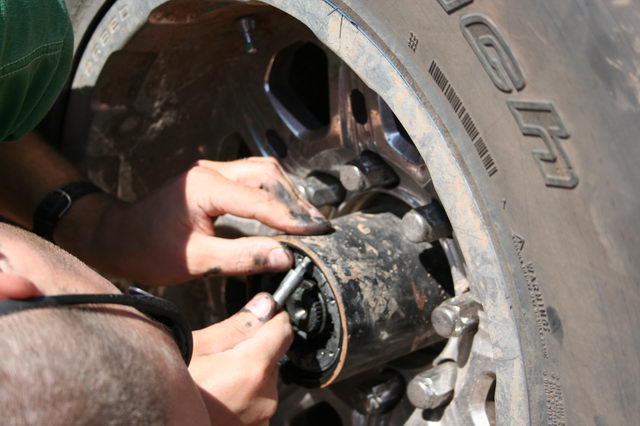
- At 20k miles or so we begain to hear and feel a dull thud once in a while while driving at slower speeds off-road. It was negligable, and we initially assumed it was just sloshing in the water or fuel tanks which we also hear and feel. At about 28k miles it begain to become noticably louder and more tactile. During an inspection under the van I found that the rear output yoke on the Atlas transfer case was not holding the U-joint firmly, the driveshaft had about 2mm of play along the U-joint axis, and the bearing caps were free to spin. SMB confirmed this was a known flaw with some of the Atlas output yokes and sent a replacement.
- Around 30k miles after a day on a fairly wash-boardy road we found that one of the bolts on the bottom of the Atlas transfer case was missing, along with all of the gear oil. All of the other bolts holding the bottom plate of the transfer case were also found to be loose.
What we added/changed:
- I removed the right fender flare and pushed some of the mounting tabs for the fender plastic back in (look to have been bent at some point). The tire no longer brushes against this when turning right.
- Sportsmobile provided us a new set of front spring packs, and an extra leaf for each rear spring (couple hundred bucks for these, I traded them the front spring install cost instead since I did it myself). The new front packs have about 1 to 1/2" more arch than the old ones, one of the middle leafs is a bit longer than in the old packs, and the second to top spring wraps around the bushings a bit more. These resulted in 2" more height at the rear axle (measured at the bump-stops) and about 3/4" at the front. Considering the low cost of the additional leafs in the rear, I would seriously advocate that anyone who may carry something on the rear of an RB van (like our motorcycle) get these. The van no longer looks like it is squatting backwards, and when parked on the flat, our couch, shelves, and counters inside are level instead of tilting slightly to the back.
- The rear drive-shaft has been replaced by a Tom Wood's unit. This was due to a fubar on my part, where the wheels spun up on a rock pile, kicked a rock out from under the right rear, and the van dropped down onto the drive-shaft. Tom Wood's shop was very helpful and quick to get me a new custom shaft, and the ride with it is even smoother than with the original shaft before the damage. Hopefully more careful driving and the lockers will prevent future such occurrences.
- When the shock mounting plate broke Sportsmobile sent us a new set of plates for both sides with a small brace added under the shock mount. Time will tell if this is sufficient. I believe the basic design of the plate is flawed, with the load of the shock away from any support the plate will flex at its weakest point, where the U bolt holes are drilled.
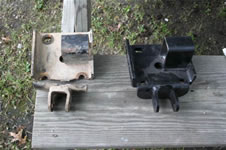
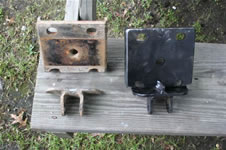
- We have installed ARB locking differentials in both axles as there have been a few times where we encountered very slippery muddy going, and would have liked a bit more reserve if the wheels started spinning even more. We are also finding that the lockers would help with some of the rock-climbing we find ourselves doing, where 2 wheels (one on each axle, usually diagonally opposed) will start to spin, and we go nowhere. The differentials were (unsatisfactorily, in my opinion) installed by 4x4 Parts in Salt Lake City, while I did the plumbing and electrics. Air pressure is provided through a regulator off of our onboard air system, instead of a separate ARB compressor system as Sportsmobile provides.
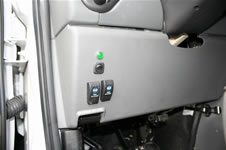
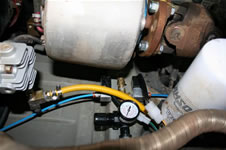
- As we approached our second winter in the van we decided that the tread on the tires was getting a bit thin for the thick mud and slush we had encountered last winter. New tires were to be had, and while we were at it we went for larger. 37" in fact. These required wheels with a bit of exterior offset to preserve the turning radius, and thus we ordered 17x10" rims with 37x12.5 BFG Mud Terrain tires. Installation was involved, requiring a fair bit of fender trimming both front and back. After installation the ride was notably softer with the larger radius and lower pressure. Washboard that had rattled our teeth out before was more of a sound than a tactile feeling, and the extra 2" of clearance is much appreciated. Time will tell on the new tread pattern's utility to our usage.
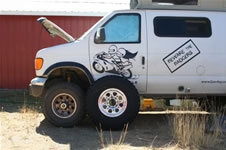
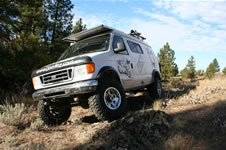
- Siped the lugs on the new 37" MT tires for better traction in wet and icy paved conditions with an Ideal heated tire groover.
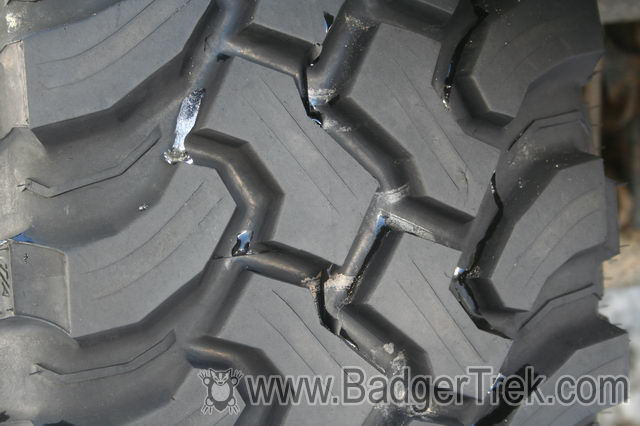
ExtremeAire Compressor & Tank -- Very useful and handy. The compressor does take a while to fill the tank at the pressure of the cut-off switch (150psi). The line to the tank is split for feeding a compact regulator that feeds the ARB control solenoids. For driving air-tools at consistent pressure we have setup a detachable pressure regulator. The coiled air-hose now has a swivel adaptor on the end so that the hose puts less stress on the valve-stems when filling, and tools are easier to maneuver. Airing up 285x75x16" tires from 35 to 65psi takes 5 to 10min per.
Issues:
- Above about 7000 feet the compressor cannot get the system up to the cut-off pressure, so the compressor will run without stopping. A 120psi cutoff switch would solve this problem without too much loss of capacity in the tank.
- The compressor pulls its power off of the engine battery rather than the house-battery. This results in the problem that airing up a bunch of tires with the engine not running might result in you being unable to start your engine. Pulling power from the house-battery would avoid this potential problem, as well as pulling power from a much larger bank and one that is designed for deep-cycling.
- The air-intake for the compressor is under the van, which can be a very dirty environment (dust), as well as potentially sucking in water if the intake is under-water when the compressor decides to fire-up. Currently we need to remember to pull the compressor's breaker before entering deep water.
What we added/changed:
- Replaced compressor on/off switch with a switch containg an "ON" LED light so we can quickly tell when the compressor is powered up.
- Moved the 1-way valve from the system's air tank to the compressor outlet to allow for branching off the air supply line for the ARB locker air supply.
- After talking with ExtremeAir about our altitude issues with the compressor, they did a free replacement for their latest and greatest and asked for our old unit back. The new compressor looks pretty much the same (bit longer) but draws a lot more power and is MUCH faster at airing up tires. It also has NO problems filling the tank to cutoff pressure at well above 10,000' altitude in just a minute or two. They theorized our old compressor had a bad seal somewhere preventing it from building sufficient pressure.
